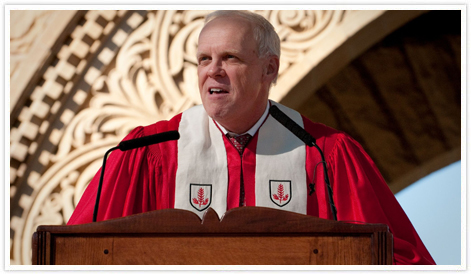

Positioning for the Future
by President John Hennessy
This year marks the end of the first decade of the century, and just as Stanford’s first 15 years were spent in what David Starr Jordan famously characterized as the university’s “second stone age,” this year saw the construction of a number of new buildings. This construction boom led to the opening of six new academic buildings in the past year with a number of additional ones scheduled for the next few years.
These new facilities will replace outmoded buildings dating back to the 1950s and 1960s in engineering, medicine and the sciences and will help Stanford realign its design to the original plan developed by renowned architect Frederick Law Olmsted at the founding of the university. More important, these buildings carry Stanford forward to a bold new future.
One of the most important roles of the research university, especially Stanford, is to serve as the incubator for innovation, and at the new Jen-Hsun Huang Engineering Center, the faculty selected inspirational quotes to feature throughout the building. Among them, John Gardner’s advice seems particularly apt as we go forward: “We may learn something about the renewal of societies if we look at the kind of individuals who contribute most to the outcome — the innovators.”
Among the most important new directions at Stanford over the past few years has been a set of multidisciplinary initiatives — in human health, environmental sustainability and international peace and security — all areas that present significant problems in this century. To support these efforts, we launched The Stanford Challenge. Now in its fifth and final year, The Stanford Challenge is an investment in the ingenuity of the Stanford faculty and students for the long-term benefit of society.
Our multidisciplinary initiatives were designed as experiments to cultivate the imaginations of our faculty, researchers and students. These early initiatives offered a framework to guide their work, and seed money facilitated the process. As the initiatives evolved, some deviated from initial guidelines, but all served their purpose: They gave people the freedom to think differently about problems and to consider new ways of collaboration in research and teaching.
As we began the process of rejuvenating older portions of the Engineering and Medicine buildings and grounds, we determined that our new facilities should be designed to embrace and enhance these new multidisciplinary efforts. And, naturally, revolutionary advances require cutting-edge facilities. For example, the new Lorry I. Lokey Stem Cell Building brings together faculty from many departments in the School of Medicine focused on both the fundamental biology of stem cells and the critical area of regenerative biology. It is also the largest laboratory for stem cell research at any U.S. university.
The new Li Ka Shing Center for Learning and Knowledge (LKSC) serves as the home for the School of Medicine as well as providing desperately needed teaching and student facilities. One of the highlights of the building is the new surgical simulation suite, providing a method to train surgeons using highly realistic mannequins and simulation systems. Together, the LKSC, the Lokey Stem Cell Building and the Clark Center, which houses several interdisciplinary activities including Bio-X and Bioengineering, enable the School of Medicine to present a new front on Campus Drive, one designed to encourage collaboration with Biology, Chemistry, Physics and Engineering all directly across Campus Drive.
Although I have focused on some exciting new facilities in this introduction, the core of the university and its excellence still depends on people, primarily the faculty and students. As detailed in the accompanying sections, our faculty, researchers and students have taken the initiatives in new directions, demonstrating proof of concept by advancing technologies, pioneering new fields and developing new approaches to teaching and learning. We must ensure that we maintain the best faculty and have the resources to fully support student financial aid during the five to ten years it will take to rebuild our endowment in the aftermath of the 2008-09 market crash.
One hundred and fifteen years ago, Stanford’s first president, David Starr Jordan, exhorted the Pioneer Class:
“The best-spent money of the present is that which is used for the future. … The university stands for the future.”
This is the foundation upon which we stand. We are positioning the university for a future of possibility: equipping it to do groundbreaking research and teaching and extending Stanford’s legacy of excellence well into the decades to come.
